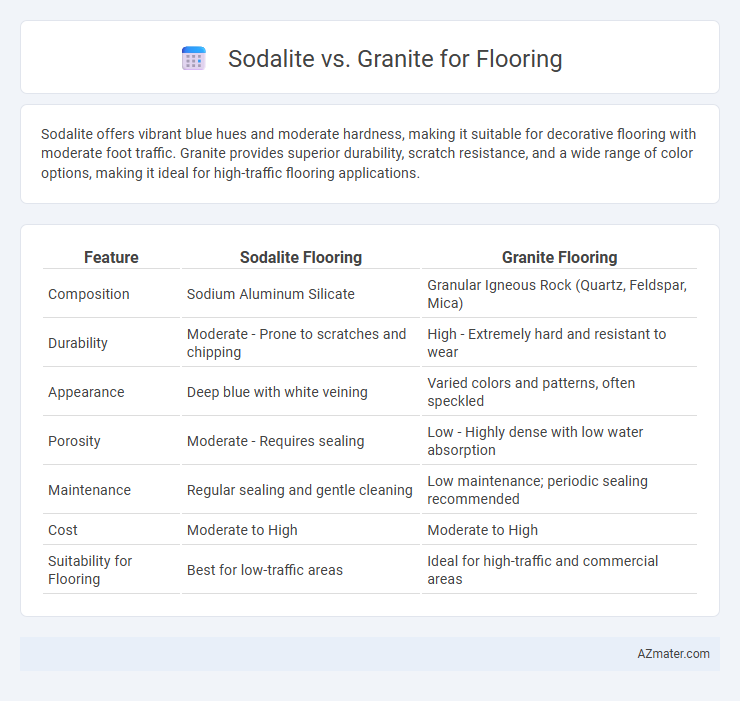Sodalite offers vibrant blue hues and moderate hardness, making it suitable for decorative flooring with moderate foot traffic. Granite provides superior durability, scratch resistance, and a wide range of color options, making it ideal for high-traffic flooring applications.
Table of Comparison
| Feature | Sodalite Flooring | Granite Flooring |
|---|---|---|
| Composition | Sodium Aluminum Silicate | Granular Igneous Rock (Quartz, Feldspar, Mica) |
| Durability | Moderate - Prone to scratches and chipping | High - Extremely hard and resistant to wear |
| Appearance | Deep blue with white veining | Varied colors and patterns, often speckled |
| Porosity | Moderate - Requires sealing | Low - Highly dense with low water absorption |
| Maintenance | Regular sealing and gentle cleaning | Low maintenance; periodic sealing recommended |
| Cost | Moderate to High | Moderate to High |
| Suitability for Flooring | Best for low-traffic areas | Ideal for high-traffic and commercial areas |
Introduction: Sodalite vs Granite Flooring
Sodalite flooring offers unique deep blue hues with striking white veining, providing a distinctive aesthetic not found in traditional granite. Granite floors are renowned for their exceptional durability, resistance to scratches, and variety of colors suitable for high-traffic areas. Both sodalite and granite serve as durable natural stone flooring options, but sodalite emphasizes bold visual impact while granite excels in practical strength and versatility.
What is Sodalite? Key Properties
Sodalite is a deep blue, tectosilicate mineral known for its rich, royal blue color often intermixed with white veins or patches, making it highly prized for decorative flooring. Key properties include a Mohs hardness of 5.5 to 6, moderate toughness, and good resistance to moisture and weathering, though it is softer and more porous than granite. Its unique aesthetic appeal combined with moderate durability positions sodalite as a striking, but less robust, alternative to the tougher, more abrasion-resistant granite in flooring applications.
What is Granite? Key Characteristics
Granite is a natural igneous rock composed primarily of quartz, feldspar, and mica, known for its exceptional hardness and durability. Its unique granular texture and wide range of colors make it a popular choice for high-traffic flooring applications. Granite's resistance to scratches, stains, and heat ensures long-lasting performance and low maintenance in residential and commercial flooring projects.
Visual Appeal: Color and Patterns
Sodalite flooring showcases striking deep blue hues with white veining, creating a bold and unique visual impact, while granite offers a diverse range of colors, from earthy tones to vibrant shades, featuring intricate natural patterns that vary by slab. The consistent richness of sodalite's blue contrasts with granite's more varied palette, making sodalite a statement choice for dynamic, luxurious interiors. Granite's versatility in pattern and color makes it suitable for a wide range of design styles, whereas sodalite's distinct appearance provides a dramatic and exclusive aesthetic.
Durability: Sodalite vs Granite Strength
Granite is renowned for its exceptional durability and high compressive strength, typically ranging from 130 to 260 MPa, making it one of the toughest natural stones for flooring applications. Sodalite, while visually striking with its deep blue hues, has lower hardness and strength compared to granite, resulting in less resistance to wear and impact over time. For high-traffic flooring areas requiring long-term durability and minimal maintenance, granite is generally the superior choice due to its robust physical properties.
Maintenance and Cleaning Requirements
Sodalite flooring requires gentle cleaning with pH-neutral cleaners to prevent surface damage and maintain its vibrant blue hues, while granite is highly durable and can withstand more aggressive cleaning agents without losing its polish. Regular sealing is essential for both materials to protect against stains, but granite generally demands less frequent resealing due to its denser composition. Dust mopping and prompt spill cleanup are crucial for sodalite to avoid etching, whereas granite floors tolerate more robust maintenance routines with minimal risk of wear.
Cost Comparison: Sodalite vs Granite
Sodalite flooring generally costs between $7 to $14 per square foot, making it a budget-friendly option compared to granite, which ranges from $40 to $100 per square foot. Granite's higher cost reflects its durability, unique patterns, and strong market demand for premium surfaces. Choosing sodalite offers significant savings for aesthetic appeal, while granite remains a costly investment favored for long-term value and luxury.
Installation Process and Considerations
Sodalite flooring requires careful sealing before installation to prevent staining due to its porous nature, while granite is denser and more resistant, often allowing for easier installation with standard adhesives. Both stones demand a flat, sturdy subfloor to avoid cracking, but granite's hardness makes cutting and shaping more labor-intensive compared to sodalite. Consider the location and foot traffic; granite offers superior durability and longevity, whereas sodalite's unique aesthetic benefits from gentle handling during installation to maintain its vibrant blue hues.
Best Applications for Each Material
Sodalite flooring is best suited for interior spaces requiring aesthetic appeal with bold blue hues and unique veining, such as living rooms, bathrooms, and feature walls. Granite excels in high-traffic areas like kitchens, hallways, and commercial spaces due to its superior durability, resistance to scratches, and low maintenance. Both materials offer distinct visual and functional benefits, with sodalite favored for decorative use and granite for durability and practicality in flooring applications.
Conclusion: Choosing the Right Stone for Your Floor
Sodalite offers a unique, vibrant blue color with a smooth texture ideal for statement floors, while granite provides exceptional durability and a wide range of colors suited for high-traffic areas. For long-lasting flooring, granite is preferred due to its resistance to scratches and staining, making it practical for both residential and commercial spaces. When aesthetics and bold appearance are prioritized in low-traffic zones, sodalite serves as an elegant, eye-catching alternative.

Infographic: Sodalite vs Granite for Flooring
 azmater.com
azmater.com